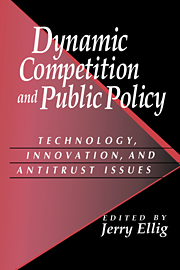Book contents
- Frontmatter
- Contents
- List of Figures and Tables
- Acknowledgments
- List of Contributors
- Introduction
- 1 A Taxonomy of Dynamic Competition Theories
- 2 Competence Explanations of Economic Profits in Strategic Management: Some Policy Implications
- 3 Innovation and Antitrust Enforcement
- 4 New Indicia for Antitrust Analysis in Markets Experiencing Rapid Innovation
- 5 Innovation and Monopoly Leveraging
- 6 Network Effects and the Microsoft Case
- 7 Technological Standards, Innovation, and Essential Facilities: Toward a Schumpeterian Post-Chicago Approach
- 8 Intellectual Property and Antitrust Limitations on Contract
- 9 Conclusion
- Index
6 - Network Effects and the Microsoft Case
Published online by Cambridge University Press: 05 June 2012
- Frontmatter
- Contents
- List of Figures and Tables
- Acknowledgments
- List of Contributors
- Introduction
- 1 A Taxonomy of Dynamic Competition Theories
- 2 Competence Explanations of Economic Profits in Strategic Management: Some Policy Implications
- 3 Innovation and Antitrust Enforcement
- 4 New Indicia for Antitrust Analysis in Markets Experiencing Rapid Innovation
- 5 Innovation and Monopoly Leveraging
- 6 Network Effects and the Microsoft Case
- 7 Technological Standards, Innovation, and Essential Facilities: Toward a Schumpeterian Post-Chicago Approach
- 8 Intellectual Property and Antitrust Limitations on Contract
- 9 Conclusion
- Index
Summary
Much of our work has examined the logic and empirical support for concepts of lock-in and path dependence. These topics have now entered the realm of public policy in what may be the most important antitrust action, or at least the most famous, since the Standard Oil case almost one hundred years ago.
Network effects occur when the value consumers receive from a product increases as the number of users of that product increases. Archetypal examples are fax machines and telephones, which have virtually no value to a consumer if only one consumer has one, but have increasing value as additional users adopt the product.
As long as other factors, such as increasing costs, do not overpower network effects, larger firms or networks will have advantages over smaller firms or networks. Following through the logic of the model, this leads, naturally enough, to a single winning firm or network. Network effects share an important characteristic with economies of scale. In particular, both confer an advantage on larger firms in an industry, although the former does it by increasing demand and the latter by decreasing costs.
A portion of this literature claims that network effects tend to keep a leading firm's position intact, even if there is a superior product available, a result otherwise known as lock-in. We need to make clear that our definition of lock-in does not just imply that costs of switching make it uneconomic to switch. If it is uneconomic to switch, switching should not occur.
- Type
- Chapter
- Information
- Dynamic Competition and Public PolicyTechnology, Innovation, and Antitrust Issues, pp. 160 - 192Publisher: Cambridge University PressPrint publication year: 2001
- 6
- Cited by



